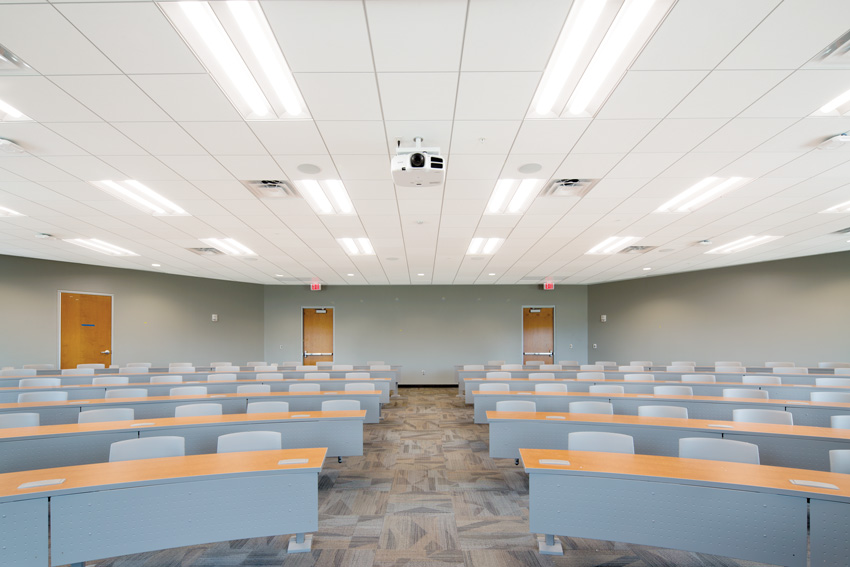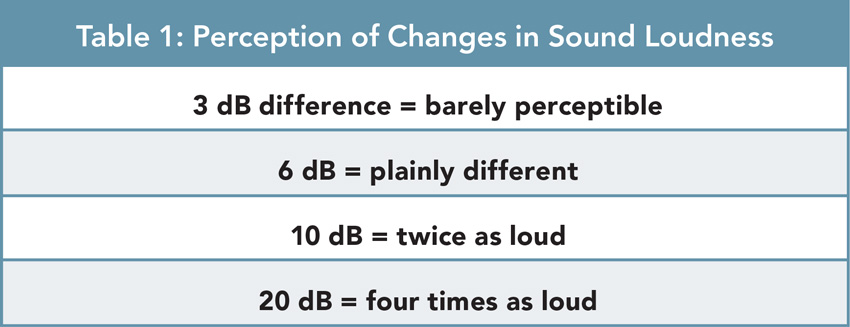Optimizing Acoustics for Effective Sound Design and Performance
While in general there are differences in the requirements among various building types, let’s now take a closer look at three of the main trends we’re seeing in all of the acoustic standards, guidelines, and building rating systems.

As standards and guidelines have become more stringent, more building types need to meet acoustics criteria or specific performance metrics.
1. Many more building types now have some sort of acoustic criteria or performance metrics applied to them. As noted in the sidebar, these include offices, schools, health-care facilities or sustainable buildings, etc.
2. As absorption requirements are becoming more stringent, ceiling products, such as stone wool ceiling panels with high noise reduction coefficient ratings (NRC), are a primary way for the building to comply with the latest acoustics criteria. NRC is a measure of how much noise is absorbed by a ceiling or other interior finish. The higher the NRC, the less noise propagation and disturbances there will be. When lower NRC ceiling panels are used (below 0.70), additional sound absorption on the floor and walls might be needed—an avoidable cost. (We will discuss this in more detail later in this article.)
The other way that the need for increased absorption is expressed in the standards is shorter reverberation time (RT60), which is the length of time required for reflected sound to decrease 60 dB or a loud sound to become inaudible as it dissipates in the room. You achieve shorter RT60 through higher NRC values, resulting in better speech intelligibility. In other words, the room reflects sound less when you have higher absorption that results in greater speech intelligibility, lower noise levels, and better sound privacy.
3. We are also seeing higher blocking required in the standards. With the more stringent standards, higher sound privacy between enclosed rooms is required. Typically, you’ll see this expressed as sound transmission class (STC), which is a measure of how much noise transmits through the walls (or other assemblies). The higher the STC value, the more privacy you’ll experience. To meet the higher sound-privacy requirements, full-height walls or plenum barriers must be used. The old practice of stopping the wall at the ceiling level and relying on the ceiling to block noise transfer does not comply with the new, higher requirements in the standards. In a nutshell, in the past, when both absorption and blocking criteria were less stringent or not defined at all, stopping the wall at the ceiling and relying on less-absorptive ceiling panels to block noise was more common. Now that the acoustic standards apply to more types of buildings and both the absorption and blocking criteria are more stringent, that old design approach fails to meet both the absorption and blocking criteria. In other words, a total failure.
What About CAC?
Another question we need to ask is, “Where is ceiling attenuation class (CAC) in all of the new acoustics standards, guidelines, and ratings systems?” The basic answer is, it’s not used. CAC is a measure of how much noise transmits through the ceilings over a partial-height wall, via a common plenum. CAC is associated with a subpar acoustic design approach because when you don’t run the wall past the ceiling plane to block sound, you are relying on the ceiling alone, which doesn’t produce good results. This is why we are not seeing CAC as a performance metric and it’s not used in most current standards, guidelines, and ratings systems.
Debunking Myths and Telling Truths
Some designers still stop the walls at the ceiling level, creating a plenum above, and then poke the ceiling system full of holes with return air grilles, supply diffusers, lights, speakers, sprinklers—the list goes on and on. Sometimes they even sacrifice ceiling panel absorption performance (NRC) for slightly higher blocking performance (CAC). This is called the “old compromise.”
Let’s explore some myths behind the old compromise as they perpetuate the dissatisfaction with acoustics we see with building post-occupancy surveys. Then we’ll discuss the truths.
Debunking Acoustic Myths
- It is alright to sacrifice ceiling NRC (absorption), even in open spaces, for slightly higher CAC (blocking) capacity. It isn’t.
- Suspended modular acoustic ceilings alone can be used for effective sound blocking, providing enough noise blocking between rooms. They can’t.
- The performance of the ceiling (CAC) can be less than the performance of the wall (STC). It can’t. They should be equal.
- The lights, speakers, diffusers, grilles, etc. that penetrate a ceiling system have no significant effect or can be ignored. Not true. Noise flanking paths through the ceiling decrease blocking capacity.
- The ceiling panel CAC rating can also be used as the ceiling system CAC rating. It can’t. It leads to disappointment after occupancy
Truths: Getting to True Sound Experience
- Truth: Sacrificing absorption (NRC) can result in noncompliance with performance metrics (standards, guidelines, and rating systems).
NRC and RT60 are inversely related. As NRC increases, RT60 decreases, which is considered better in most cases and what we’re trying to do. For instance, let’s say we received a reverberation time requirement either from our consultant, a standard, or guidelines—or we happen to know what our desired reverberation time is. From there, it’s a simple calculation (which we will discuss in detail later in this article) to get the minimum NRC for our ceiling. Anything below that minimum is going to result in noncompliance with the required performance level, regardless if it’s a noticeable difference or not. Conversely, anything at or above that minimum is still going to result in compliance.
Additional absorption on the walls or the floors may be required to compensate for deficiency in the ceiling NRC.
- Truth: Ceiling panels can’t provide enough blocking on their own to achieve speech privacy and avoid annoyance.
The STC rating of most walls vary from about 40 to 60 points. STC 60 is considered high, but it requires special and heavy construction. STC 40 to 50 walls are considered more commonplace for contractors as they build these assemblies every day, requiring nothing special or out of the ordinary. These STC ratings are based on decades of actual human perception and annoyance in real buildings. These are the blocking levels mandated in the standards, guidelines, and rating systems.
However, CAC ratings of most ceilings panels vary from about 20 to 40 points. That means that on a good day, the best-performing ceiling panels (CAC) might perform about the same as the worst performing walls (STC). But that’s before we even start talking about all the penetrations in the ceiling system. So why the disparity? It’s because what we regard as high and low STC ratings for walls is based on human perception and annoyance proven in real buildings. But that’s not true with CAC. What we consider high and low CAC for ceiling panels is based only on what’s available in the market.
- Truth: Accepting lower absorption performance (NRC) for higher blocking (CAC) results in total failure.
We discussed earlier not sacrificing NRC for CAC or blocking. To get CAC performance in the 30 to 40 range, you typically, but not always, have to drop your NRC down to as low as 0.50, 0.60 and 0.70. This means, though, you’re simply sacrificing your absorption for what is still an inadequate level of blocking. As a result, you are failing to meet both the absorption and blocking requirements, going back to that idea of the “old compromise,” or a total failure.
The most common wall performance required by the standards at STC 45 to 50 outperforms CAC 30 to 35 ceilings by 10 to 20 points, meaning the sound that comes through the ceilings is two to four times louder than what’s coming through the wall. Once you then add in the effect of all the noise leaks resulting from lights, grilles and diffusers, the disparity grows even worse.
- Truth: Overall, sound blocking and sound privacy between rooms is only as good as the weakest link.
Neither the sound path through the wall or through the ceiling is more important than the other. Sound blocking provided by the ceilings (CAC) is insufficient relative to that provided by the walls (STC). The sound-blocking capacity of the ceiling (CAC) must match the sound-blocking capacity of the wall (STC = CAC), but it can’t. Ceiling performance falls short of the wall performance so the ceiling cannot match the performance of the wall.
- Truth: Noise-flanking paths through the ceiling will affect blocking capacity.
The lights, speakers, diffusers, grilles, etc. that penetrate a ceiling system have significant effect and can’t be ignored. These penetrations can decrease the performance of the ceiling system 10 CAC points and more than 20 dB in the important high frequencies, which make speech intelligible.
When ceiling manufacturers test their panel ratings for CAC, they only have their ceiling panels in the suspension grid.
They don’t test a realistic ceiling system with devices for air distribution, lighting, fire suppression, security surveillance, etc. Recently, when one building manufacturer and NGC Testing Services tested a high-performance ceiling panel with a rating of CAC 43, the lights and air devices alone dropped the ceiling rating down by 9 points, to 34. When they tested another panel with a CAC rating of 37 and had the same leaks, the rating dropped by 10 points, to 27.
While CAC decreases 10 points due to holes in the ceiling, blocking of speech-privacy frequencies decreases 15 to 22 dB (see Table 1). Generally, neither of these can provide speech privacy between rooms. Now compare the CAC 27 and 34 ratings for these ceiling systems with leaks to STC 40, 45, and 50 wall performance. As mentioned earlier, the truth is that ceiling panel CAC ratings is not the same as ceiling system CAC ratings in a real building.5










